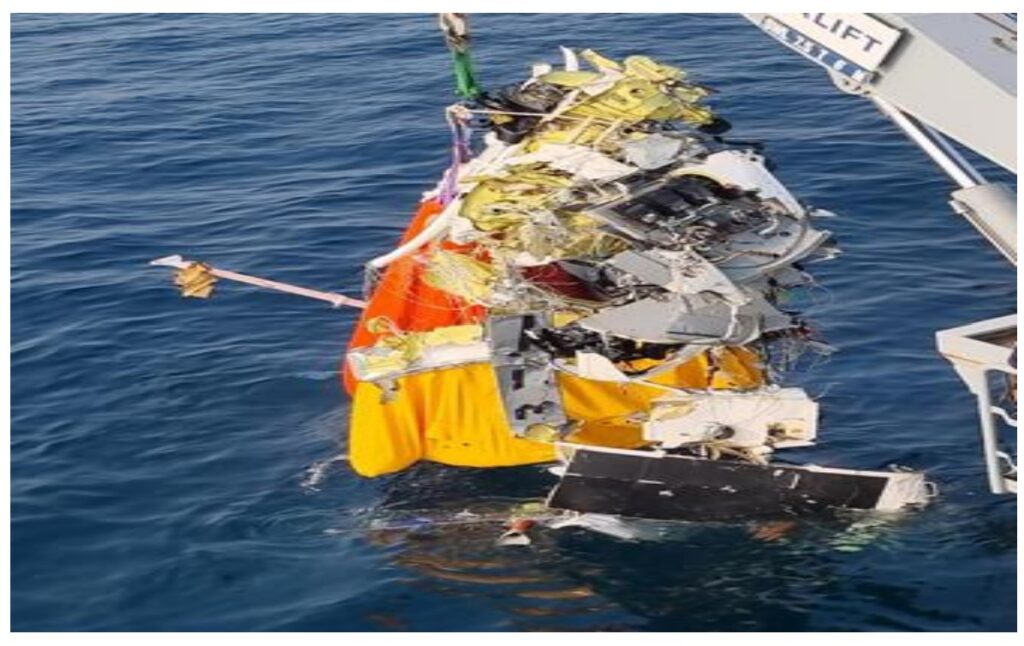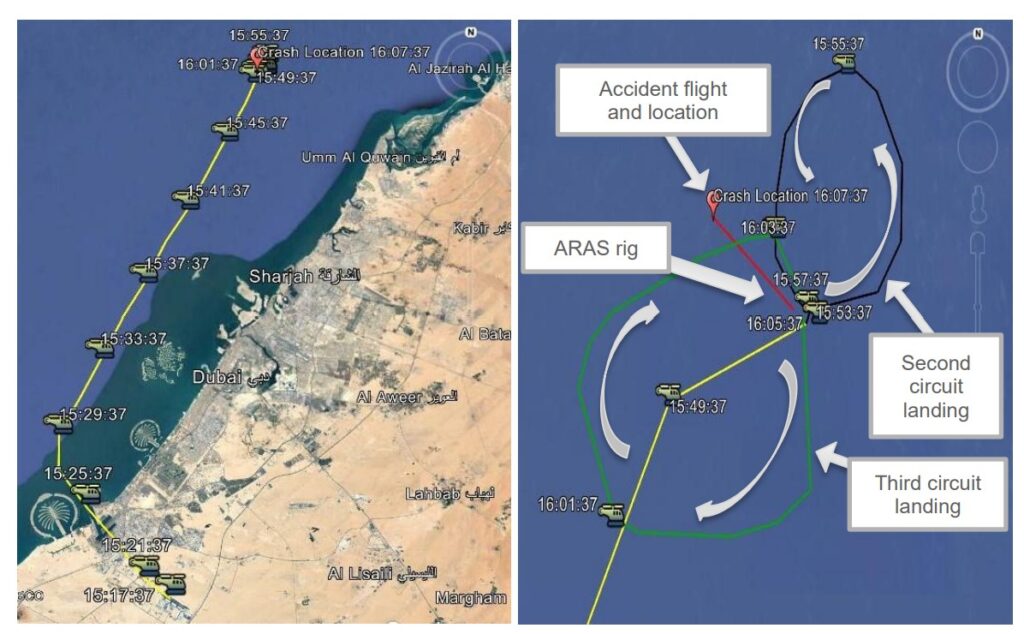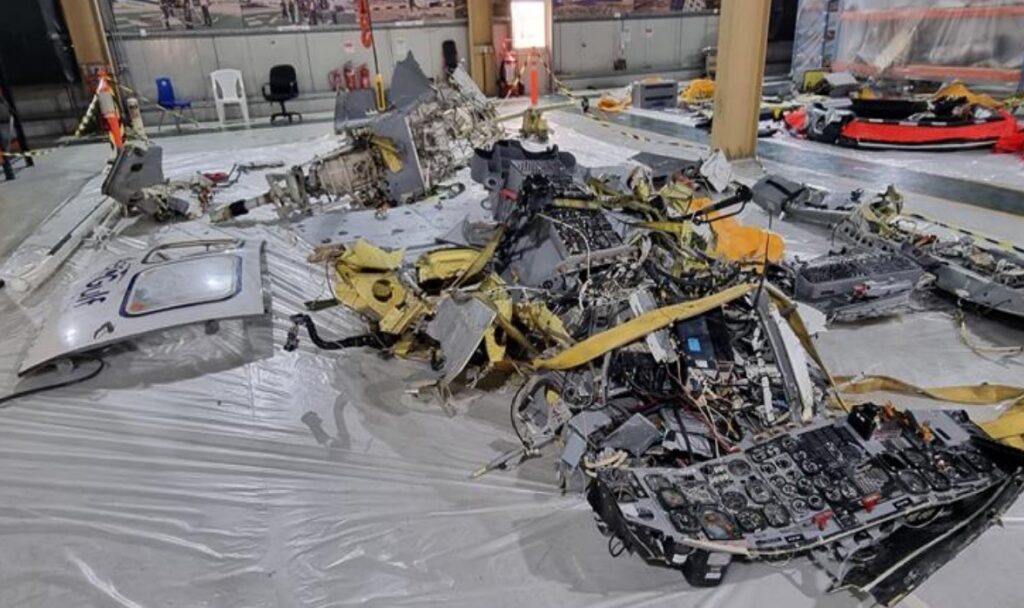Investigation into B212 Offshore Helicopter Accident off UAE 7 September 2023 (Aerogulf A6-ALD)
On 7 September 2023 Aerogulf Services Bell 212 A6-ALD crashed into the Arabian Gulf of the UAE at c 20:06 Local Time during a night offshore training flight. Both pilots were fatally injured.

Debris Recovered from Crash of Aerogulf Bell 212 A-6ALD (Credit AAIS)
The Accident Flight
The Air Accident Investigation Sector (AAIS) of the United Arab Emirates GCAA, in a preliminary report, issued 6 October 2023, stated that the helicopter departed Al Maktoum International Airport (OMDW), Dubai, for the Aras Driller jack-up drilling rig located off the emirate of Umm Al Quwain at c 19:18 Local Time. The Aircraft Commander (9011 hours total time), the trainer, was in the left seat as pilot monitoring (PM), and the Co-pilot (7031 hours total time) was the pilot flying (PF) in the right seat. The intent was to make 5 offshore landings to maintain night recency. The Aerogulf Ops Manual Part D states…
..flight crew will keep their night recency using a FFS [Full Flight Simulator] or the real aircraft completing 3 night take off, each followed by a traffic pattern and a subsequent landings every 90 days.
The training objective were:

The helicopter climbed to 1100 ft and proceeded along the coast to the jack-up with an ETA of 19:40 Local Time.
At 19:38 Local Time the radio operator on Aras Driller passed the latest weather data: “rvariable windspeed ranging from 7 to 9 knots coming from the 60°, visibility between 7 to 8 knots [sic – presumably nautical miles or km] and 1002 millibar air pressure”.
At 19:46 Local Time the PM contacted the radio operator to inform him that they were 2 minutes away from landing. The radio operator confirmed they had a ‘green deck’ (i.e. the helideck was available).
At 19:50 Local Time, the Bell 212 landed on helideck, heading southeast. It took off ay 19:52 Local Time and headed north east. Within 3minutes, it turned and descended for a second landing, again heading south east. After the second landing, it took off again at 19:59 Local Time and performed a second circuit landing for the third time at 20:03 Local Time.

Flight Path of Aerogulf Bell 212 A-6ALD (Credit AAIS)
At 20:05 Local Time, the helicopter took off again. One minute later the Helideck Landing Officer (HLO) called the radio operator, reporting that the helicopter had crashed c 600 m away to the north west.
The Search and Rescue (SAR) Activity
At 20:08 Local Time, the radio operator notified the rig management and initiated a distress call for SAR. The rig launched a fast rescue craft. They were not able to locate any survivors but found an inflated liferaft with some debris attached
The investigators say:
The SAR rescue team reached the site in about 45 minutes after they were notified. The team swiftly initiated operation within the designated area.
Its not clear what SAR asset this was, but it appears to have been a boat, as they go on to say:
About 1 hour 20 minutes after the initial notification, a SAR helicopter arrived at the site. Equipped with powerful high beam focus lights fitted on it, the SAR helicopter conducted an intensive survey of the anticipated site. At the same time, the SAR rescue boat gathered all floating debris, which encompassed a small part of the helicopter. The following day after…the search operation resumed, but no traces of the wreckage were found. On the day after that (9 September), the SAR team discovered a significant amount of wreckage pieces that were scattered across two separate locations, approximately 100 meters apart.
One of the pilots’ bodies was located next day of the Accident (8 September 2023), whereas the body of the other pilot was found two days later.
Later, the SAR team managed to successfully recover additional parts of the wreckage, including the cockpit, the main transmission gear, and various structural pieces,

Debris Recovered from Crash of Aerogulf Bell 212 A-6ALD (Credit AAIS)
The AAIS Safety Investigation
The safety investigation in ongoing.
Unfortunately helicopter was neither equipped with a flight data recorder (FDR) or cockpit voice recorder (CVR), nor due to its age was it required to be by regulation. It did have a Altair Smartcyle+ engine recorded that was recovered and Skytrac DSAT 300E satellite tracking (transmitting every 2 minutes).
AAIS say:
The search efforts are currently underway to locate the main components that are still submerged underwater. Special focus is being given to finding the engines, main rotor, tail rotor, and tail rotor shaft. Once all or part of the remaining wreckage is located, the Investigation plans to conduct a forensic examination of these components in collaboration with both the helicopter and engine manufacturers.
The Investigation plan is as follows:
− Continue the efforts to locate and recover the main parts from underwater
− Analyze the Helicopter’s maintenance history
− Analyze the Helicopter’s performance
− Review the human factors aspects based on the available data
− Review the organizational aspects
− Identify any other safety issues that may arise during the course of the Investigation.
We will update this article as more details emerge.
Our Safety Observations
A study c 12 years ago determined offshore night operations were c 8 times the risk of daytime flights, mostly driven be organisations that rarely flew routine night flights conducting night recency training or medevacs.
Cultural lighting in the area offshore is likely to have been minimal after take off.
HeliOffshore has published an Industry Action Plan for Night Deck Landing Practice:
The report identifies fifteen common factors to both events, which naturally fall into six broad themes, leading to 21 improvement opportunities. In the majority of cases, these opportunities require a collaborative approach between multiple stakeholders to gain the maximum benefit to industry safety performance.
Safety Resources
The European Safety Promotion Network Rotorcraft (ESPN-R) has a helicopter safety discussion group on LinkedIn. You may also find these Aerossurance articles of interest:
- HEMS Black Hole Accident: “Organisational, Regulatory and Oversight Deficiencies”
- Fatal GOM B407 Offshore Take Off Accident: Safety, Helideck & SAR / Emergency Response Questions
- Helideck Heave Ho! (BHS Sikorsky S-76C++ PR-CHI)
- 2009 Newfoundland S-92A C-GZCH Accident: A Failure of Design and Certification
- Fatal Mi-8 Loss of Control – Inflight and Water Impact off Svalbard
- Canadian Coast Guard Helicopter Accident: CFIT, Survivability and More
- Korean Kamov Ka-32T Fire-Fighting Water Impact and Underwater Egress Fatal Accident
- NH90 Caribbean Loss of Control – Inflight, Water Impact and Survivability Issues
- Dramatic Malaysian S-76C 2013 Ditching Video
- Ditching after Blade Strike During HESLO from a Ship
- US BSEE Helideck A-NPR / Bell 430 Tail Strike
- AS350B3 Ditching Japan
- GOM Helicopter Ops 2000-2019: Single Engine Usage Plummets But Fatal Accident Rate Resistant
- S-92A Collision with Obstacle while Taxying
- Loss of Bell 412 off Brazil Remains Unexplained
- Offshore Night Near Miss: Marine Pilot Transfer Unintended Descent
- North Sea Helicopter Struck Sea After Loss of Control on Approach During Night Shuttling (S-76A G-BHYB 1983)
- Wrong Deck Landings
- NTSB Report on Bizarre 2012 US S-76B Ditching
- FOD and an AS350B3 Accident Landing on a Yacht in Bergen
- Night Offshore Training AS365N3 Accident in India 2015
- Loss of Control, Twice, by Offshore Helicopter off Nova Scotia
- Night Offshore Windfarm HEMS Winch Training CFIT (BK117C1 D-HDRJ)
- Blinded by Light, Spanish Customs AS365 Crashed During Night-time Hot Pursuit
- Urgent Exit Required: A Helideck Incident (Omni Sikorsky S-76C+ PR-SEC)
- UPDATE 9 Dec 2023: Fire-fighting Bell 204B Underwater Escape

Recent Comments